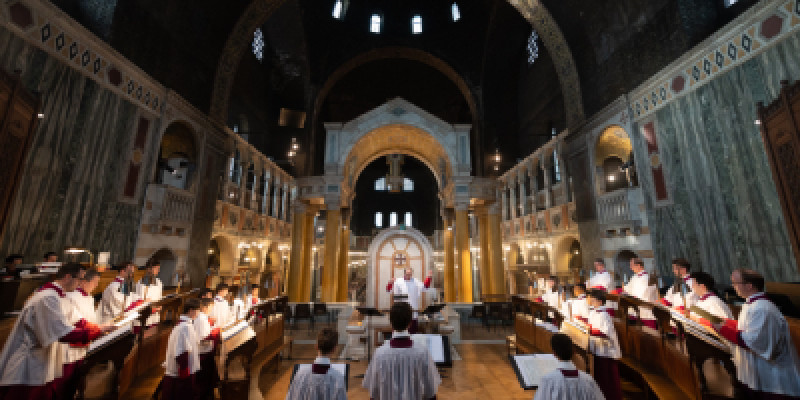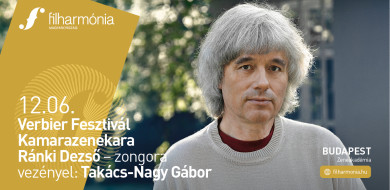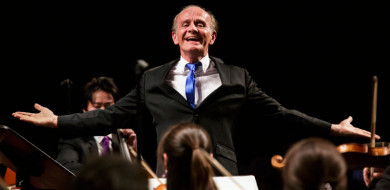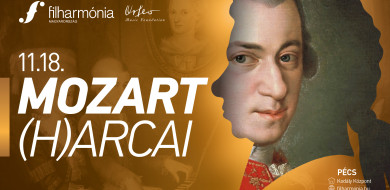Organised by Filharmonia Hungary, the Choir of Westminster Cathedral will give four concerts. The internationally renowned London-based vocal ensemble, founded in 1901, will perform on June 10 in Veszprém, June 11 at the Matthias Church in Budapest, June 12 in Pécs, and June 13 in Szeged, offering a taste of their repertoire that spans from the Middle Ages to modern vocal polyphony. But who are they, and how do they differ from the equally world-famous musicians of Westminster Abbey?
The construction of Westminster Cathedral began in 1895 under the direction of Cardinal Herbert Vaughan and architect John Bentley; the cathedral was completed eight years later, in 1903. Its unique architecture reflects the influence of ancient Christian churches. Cardinal Vaughan had no intention of competing with the Gothic grandeur of the nearby Anglican Westminster Abbey. "Instead of a poor imitation of the past, I wanted something new and original. I wanted to put Catholicism back on the map—to inspire and encourage the faithful after centuries in the shadow of the Anglican Church," said the cardinal, who was familiar with the great basilicas of Rome and was convinced that an "Italian-style" early Christian-styled church would be appropriate for Westminster. At the end of the 19th century, Catholicism was experiencing a revival in England, bolstered by Irish immigrants fleeing famine and poverty, which brought larger congregations into churches. As a result, Vaughan rejected the narrow, Gothic-style design in favour of an ample interior space that evoked the ancient history of the Church.
The construction could only be carried out through borrowing money, and under ecclesiastical law, a cathedral could not be consecrated while in debt. With the death of Cardinal Vaughan in 1903, the fundraising momentum slowed, and the task of settling the cathedral's construction debt fell to his successor, Cardinal Francis Bourne. The fundraising goal was finally reached on April 30, 1910. The cathedral was debt-free, and preparations for the solemn consecration ceremony could proceed. Bourne praised "the united generosity of Catholics scattered all over the world." The ceremonies lasted for three days, from June 27 to June 29, 1910, culminating on the great feast of Saints Peter and Paul. The Westminster Chronicle said it was "a landmark event in the history of the Catholic Church of England."
Cardinal Herbert Vaughan originally intended to establish a monastic foundation within the cathedral dedicated to church music. The singing of the Mass and the Divine Office, as well as other liturgical duties, were to be performed by "full-time" monks. The plan even reached Pope Leo XIII, but due to doubts and uncertainties, Vaughan eventually abandoned the idea and decided to establish a dedicated choir for Westminster Cathedral instead. At the time, the standard of liturgical singing in the Catholic Church in England was abysmal, and Cardinal Vaughan recognised a unique opportunity. In 1899, he attended the opening of the abbey church in Ealing, where he heard the choir of Downside Abbey, conducted by music director Richard Terry. The cardinal exclaimed, "This is the music I want for my cathedral." Within two years, Terry was appointed to Westminster to build the cathedral's musical life from the ground up.
The choir school of the still-under-construction cathedral welcomed its first boys in 1901. A year later, 25 boys and 16 men were ready to perform liturgical duties during the first service in the cathedral's nave. In addition to daily Masses and Offices, the choir also participated in significant events, including the celebrations for the cathedral's consecration. Musicologist and choirmaster Richard Terry enthusiastically researched the forgotten vocal repertoire of 16th-century England. He often spent his holidays in the British Museum, libraries, and archives, preparing new editions of works by Tallis, Byrd, and Sheppard. Alongside English late Renaissance music, Gregorian chant formed the backbone of Westminster's repertoire. According to his close colleague, monk and singer Gregory Murray, "Terry was a charismatic performer, passionately convinced—and passionate about convincing others—that this forgotten polyphony is our greatest musical heritage from the past."
After Terry left the cathedral in 1924, priests and monks oversaw Westminster's musical direction for over two decades. During World War II, services continued with sung liturgies without the children's participation. 1947, composer and conductor George Malcolm became the cathedral's music director. He collaborated closely with contemporary composers such as Benjamin Britten and Ralph Vaughan Williams. In 1961, he was succeeded by Colin Mawby, an organist, vocalist, and composer, who enriched the choir's repertoire with numerous Masses and motets in both English and Latin. By the early 1970s, the situation had become uncertain: financial crises threatened the survival of the choir school, and rapidly changing liturgical practices of the time posed further challenges to Catholic church music.
A new golden era for the Westminster Cathedral Choir began in the late 1970s when Archbishop Basil Hume—himself a former student of the choir school—reorganised the ensemble and secured financial support to ensure its continued operation. The directors appointed since then—David Hill, James O'Donnell, Martin Baker, and Simon Johnson—have followed in the footsteps of the founder, Richard Terry, encouraging composers to write new music for the choir. Among those who have composed liturgical works for the choir in recent decades are Sir James MacMillan, Sir Peter Maxwell Davies, and Judith Bingham. Today, 124 years after its founding, the Westminster Cathedral Choir is considered one of the world's most highly acclaimed church music ensembles—something the Hungarian audience can now experience firsthand.










